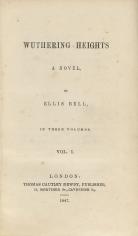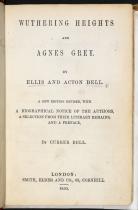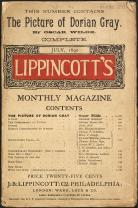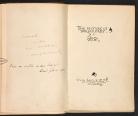How Horrifying Hearts Terrorize: Wuthering Heights and The Picture of Dorian Gray as Gothic novels
Created by Vivian Nguyen on Mon, 03/21/2022 - 00:17
My essay explores different definitions of the Gothic while providing evidence as to how Wuthering Heights and The Picture of Dorian Gray fit these various definitions and how the Gothic genre is ideal for these works.
Timeline
Chronological table
| Date | Event | Created by | Associated Places | |
|---|---|---|---|---|
| The middle of the month Winter 1847 |
Publication of Wuthering HeightsEmily Brontë wrote her first and only novel, Wuthering Heights, between October 1845 and June 1846. It was finally published on 14 December 1847 by Thomas Cautley Newby in London. This first edition was a part of a three-volume set: Wuthering Heights took up two volumes, while Agnes Grey by Anne Brontë, Emily’s younger sister, completed the set as the third volume. Brontë published under the male pseudonym “Ellis Bell” to obscure her gender and retain her privacy. Emily and her sisters desired to be respected and taken seriously as writers, which was not usually extended to female writers in the Victorian era. |
Vivian Nguyen | ||
| Winter 1850 |
Second Edition of Wuthering HeightsAfter Emily and Anne Brontë died in 1848, Charlotte Brontë took the initiative to edit her younger sisters’ works. For Wuthering Heights, she reorganized paragraphs, corrected punctuation errors, and lightened Joseph’s Yorkshire accent so he could be more easily understood. The second edition of Wuthering Heights was published in December 1850 by W.S. Williams in London. Like the first edition, it was combined with Agnes Grey. Charlotte provided the “Biographical Notice of Ellis and Acton Bell” and “Editor’s Preface to the New Edition” in this second edition of Wuthering Heights to reveal the identities of the sisters. |
Vivian Nguyen | ||
| Summer 1890 |
Publication of The Picture of Dorian GrayThe catalyst for The Picture of Dorian Gray came on 30 August 1889 when J. M. Stoddart met up with Oscar Wilde, Arthur Conan Doyle, and Rudyard Kipling in London at the Langham Hotel. Stoddart was an editor for Lippincott’s Monthly Magazine, an American periodical based in Philadelphia. He invited the three authors to write for Lippincott’s and they all agreed to the opportunity. Wilde took seven months to draft The Picture of Dorian Gray before Stoddart received it on 7 April 1890. It was finally published in July 1890 through Lippincott’s Monthly Magazine with Stoddart edits to tone down homoerotic material, which were made without Wilde’s knowledge or consent. The novella was simultaneously circulated in London thanks to Ward, Lock and Co. |
Vivian Nguyen | ||
| Spring 1891 |
Second Edition of The Picture of Dorian GrayAfter the criticisms and backlash from the first edition, a second edition of The Picture of Dorian Gray was published in April 1891 by Ward, Lock and Co. Wilde kept Stoddart’s edits from the first edition but added an additional six chapters and a preface to the text. Chapters 3, 5, and 15 to 18 are entirely new, and Wilde added to Chapter 19 and 20. Ward, Lock and Co. also took the initiative to commission artist Charles Ricketts to design the single volume in a way that reflected the artistry of the novel. Despite the efforts made by Wilde and Ward, Lock and Co., the reception of the novel were still poor. Wilde received similar criticisms as before about his artistic intentions and the morals (or lack thereof) incorporated into the work. Sales for the volume that Ricketts thoughtfully designed were low. |
Vivian Nguyen |




